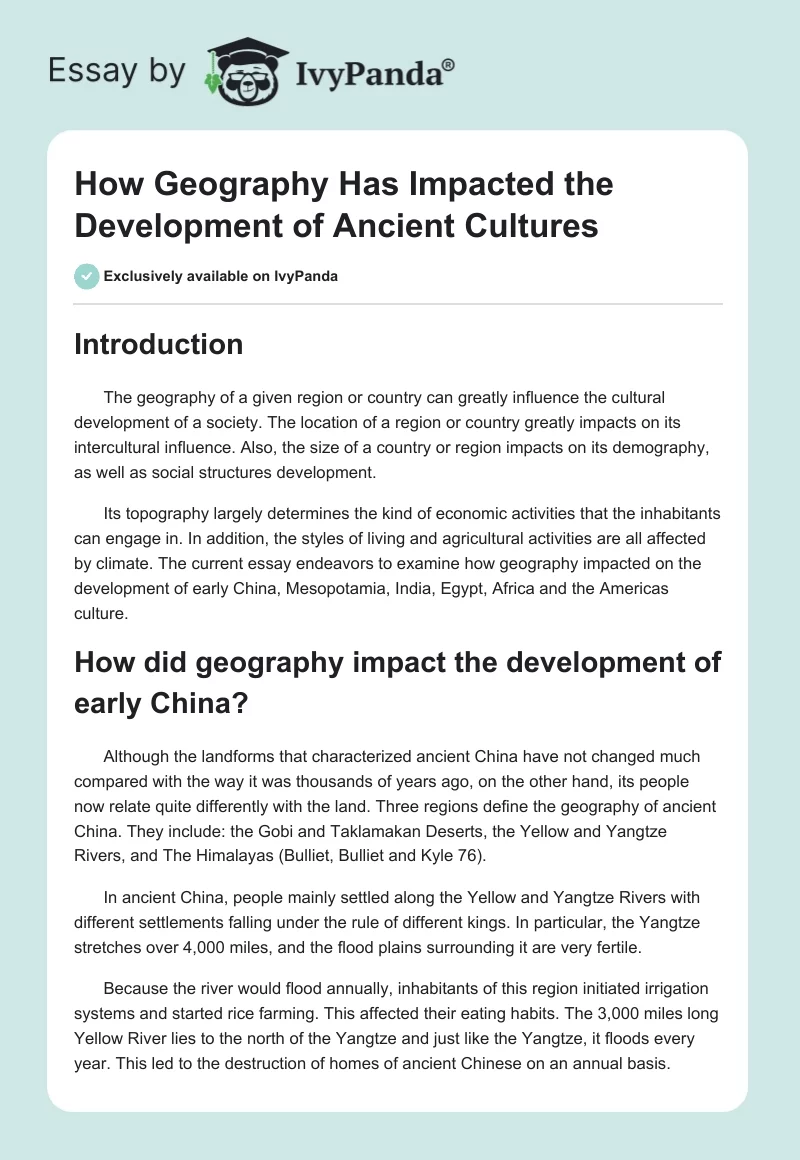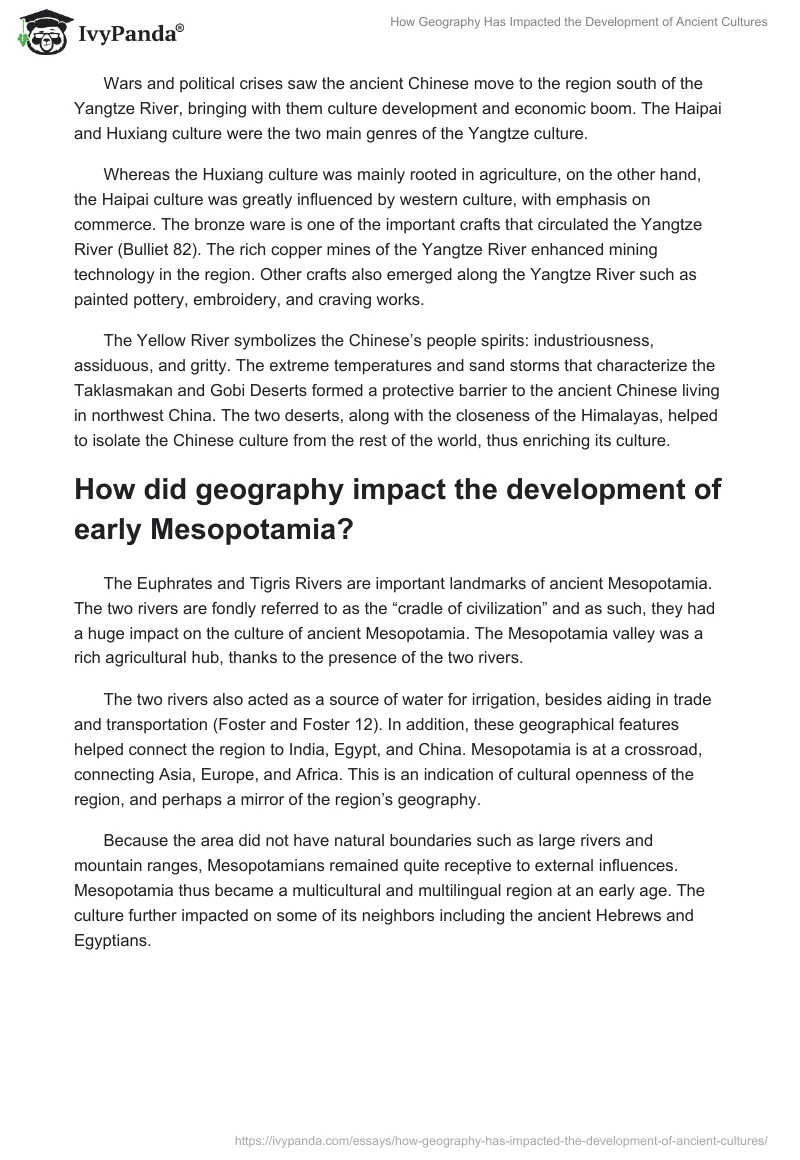- Introduction
- How did geography impact the development of early China?
- How did geography impact the development of early Mesopotamia?
- How geography has impacted the development of ancient Egyptian culture
- How the geography of India impacted on the development of ancient India culture
- How geography impacted the development of ancient African culture
- How geography has impacted the development of ancient American culture
- Conclusion
- Works Cited
Introduction
The geography of a given region or country can greatly influence the cultural development of a society. The location of a region or country greatly impacts on its intercultural influence. Also, the size of a country or region impacts on its demography, as well as social structures development.
Its topography largely determines the kind of economic activities that the inhabitants can engage in. In addition, the styles of living and agricultural activities are all affected by climate. The current essay endeavors to examine how geography impacted on the development of early China, Mesopotamia, India, Egypt, Africa and the Americas culture.
How did geography impact the development of early China?
Although the landforms that characterized ancient China have not changed much compared with the way it was thousands of years ago, on the other hand, its people now relate quite differently with the land. Three regions define the geography of ancient China. They include: the Gobi and Taklamakan Deserts, the Yellow and Yangtze Rivers, and The Himalayas (Bulliet, Bulliet and Kyle 76).
In ancient China, people mainly settled along the Yellow and Yangtze Rivers with different settlements falling under the rule of different kings. In particular, the Yangtze stretches over 4,000 miles, and the flood plains surrounding it are very fertile.
Because the river would flood annually, inhabitants of this region initiated irrigation systems and started rice farming. This affected their eating habits. The 3,000 miles long Yellow River lies to the north of the Yangtze and just like the Yangtze, it floods every year. This led to the destruction of homes of ancient Chinese on an annual basis.
Wars and political crises saw the ancient Chinese move to the region south of the Yangtze River, bringing with them culture development and economic boom. The Haipai and Huxiang culture were the two main genres of the Yangtze culture.
Whereas the Huxiang culture was mainly rooted in agriculture, on the other hand, the Haipai culture was greatly influenced by western culture, with emphasis on commerce. The bronze ware is one of the important crafts that circulated the Yangtze River (Bulliet 82). The rich copper mines of the Yangtze River enhanced mining technology in the region. Other crafts also emerged along the Yangtze River such as painted pottery, embroidery, and craving works.
The Yellow River symbolizes the Chinese’s people spirits: industriousness, assiduous, and gritty. The extreme temperatures and sand storms that characterize the Taklasmakan and Gobi Deserts formed a protective barrier to the ancient Chinese living in northwest China. The two deserts, along with the closeness of the Himalayas, helped to isolate the Chinese culture from the rest of the world, thus enriching its culture.
How did geography impact the development of early Mesopotamia?
The Euphrates and Tigris Rivers are important landmarks of ancient Mesopotamia. The two rivers are fondly referred to as the “cradle of civilization” and as such, they had a huge impact on the culture of ancient Mesopotamia. The Mesopotamia valley was a rich agricultural hub, thanks to the presence of the two rivers.
The two rivers also acted as a source of water for irrigation, besides aiding in trade and transportation (Foster and Foster 12). In addition, these geographical features helped connect the region to India, Egypt, and China. Mesopotamia is at a crossroad, connecting Asia, Europe, and Africa. This is an indication of cultural openness of the region, and perhaps a mirror of the region’s geography.
Because the area did not have natural boundaries such as large rivers and mountain ranges, Mesopotamians remained quite receptive to external influences. Mesopotamia thus became a multicultural and multilingual region at an early age. The culture further impacted on some of its neighbors including the ancient Hebrews and Egyptians.
How geography has impacted the development of ancient Egyptian culture
The Nile River is characterized by yearly floods, resulting in silt deposits. This provides fertile soil for the farming of ample crops. In Ancient Egyptian culture, people were forced to construct channeling water, reservoirs, and dikes. Geography affected Egyptian settlement. There were deserts to the west and to the east.
These created defensive barriers and limited expansion of the Ancient Egyptians who had settled along the River Nile valley (Fassbender 2). To the Egyptians, the Nile River was also a source of transport, facilitating the movements of the people up and down the river on trade excursions, and in search of food. The limestone, granite deposits and sandstones found on the banks of the Nile River helped to enhance the economic activities of the Egyptians.
How the geography of India impacted on the development of ancient India culture
The geography of Ancient India was instrumental in the development of the Indian culture, in that it paved way for trade routes with other nations and continents as well. Ancient India was characterized by many plains, rivers, mountains ranges, deserts, plateaus, and cities. All of these geographical features helped in shaping the modern lifestyles and values of India (Guisepi para. 3).
The impact of geography on India’s civilization is also quite significant since the first Indian civilization took place on the Indus-River valley. The inhabitants of the Indus-River valley had to contend with such difficult situations as the unpredictable flooding of the river. Consequently, this gave rise to engineers and plumbers to help contain the problem.
The plumbers and engineers were later on instrumental in helping to construct a sewer system for the city. The Indus-River valley was also instrumental in helping to enhance trade between Indian and the rest of Asia. The proximity of the Indians to the Himalayas helped to protect them from invasions. This was important, because, it meant that Indians got to retain their rich culture, traditions, and customs.
How geography impacted the development of ancient African culture
Ancient Africa enjoyed a favorable distribution of natural resources. For example, it received adequate rainfall and had good soils suitable for farming. The Central African region with its lowlands enjoys warm and humid conditions, receiving rainfall almost daily. The region also has vast vegetation and dense forests and this has affected human settlement (Davidson 46).
Because farming is difficult, the human population here has to relying on other activities, thereby affecting their eating habits. They cannot also raise cattle owing to the presence of tsetse flies. Historically, such activities as hunting, gathering, and fishing have helped to sustain the region’s economy. The savanna land that lies to the South and North of the equatorial forest holds the savanna farming communities (Rodney 231).
They farm indigenous savanna crops such as millet, yams, fruits, palm oil, and black-eyed peas. Nearly one-third of the African continent is covered by desert. Here, only the people living near oases or rivers can practice agriculture. As such, geography of the ancient African continent dictated the cultural development of the inhabitants, such as the mode of farming, the nature of trade, and food consumed.
How geography has impacted the development of ancient American culture
The geography of Ancient America has impacted greatly on its political, economic, and cultural development. Natural resources, topography, water bodies and climatic conditions have all determined the levels of civilization and cultural development in the region (Willner, Hero & Weiner 2006, p. 147).
Latin America was characterized by varied bodies of water and physical geography of land. As a result, some people opted to settle in lands that would allow them to attain higher levels of civilization and cultural development. Mexico, the Central America and South American also had varied topography and climate, and this has resulted in the uneven population distribution that we witness today.
For example, the huge savannah and tropical forests of the Amazonian region are sparsely populated, as well as the northern wastelands of Mexico and the Patagonia desert in Argentina (Wilner et al, 2006, p. 147). On the other hand, the Brazilian coast, the central plateau of Mexico and the Rio de la Plata plane in Argentina are overpopulated.
Conclusion
Geography can influence the shaping of culture, religion, politics, and the economy of a country or a region. The Current essay endeavored to illustrate how geography has impacted the development of ancient cultures including India, Mesopotamia, Egypt, Africa, the Americas, and China. In all these regions, the cultural orientation of the people depended to a great deal on certain geographical features of the region in question. These affected their eating habits, migration patterns, and trade.
Works Cited
Bulliet, Richard W, Bulliet, Richard and Kyle Pamela. The Earth and Its Peoples: A Global History. Stamford, Mass: Cengage Learning, 2010. Print.
Davidson, Basil. Africa in History. London: Kegan Paul, 1975.
Fassbender, Michael. How the physical geography of ancient Egypt shaped the development of its civilization. September 2011. Web.
Foster, Benjamin, Foster, Karen. Civilizations of ancient Iraq, Princeton: Princeton \ University Press, 2009. Print.
Guisepi, R. A. The Indus Valley And The Genesis Of South Asian Civilization. n. d. Web.
Rodney, Walter. Africa in the Americas and Europe. Cambridge History of Africa, 4(1986): 230-278.
Willner, Mark, Hero, George and Weiner, Jerry. Global History Volume I: The Ancient World to the Age of Revolution. New York: Barron’s Educational Series, 2006. Print.


